Looking for pencil art ideas for every style? Try minimalist botanical sketches that keep things simple, or go wild with chaotic doodle mash-ups. Sketch expressive faces, dramatic animal portraits, or real-life objects from the kitchen table. Humor shines in whimsical cartoons or goofy fantasy creatures, while dreamlike natural scenes and impossible spaces spark the imagination. Want drama? Play with shadows, mood, and bold shapes. There’s even more inspiration ahead—some ideas might surprise you!
Key Takeaways
- Explore minimalist botanical sketches that use simple lines and shading to capture the essence of plants.
- Practice dynamic action poses and realistic animal portraits to enhance anatomical drawing skills and motion.
- Experiment with whimsical cartoon characters and chaotic doodle mash-ups for playful, expressive creativity.
- Try geometric shape explorations to build spatial awareness and create visually striking compositions.
- Create still life drawings featuring everyday objects or food, focusing on texture, composition, and natural lighting.
Minimalist Botanical Sketches
Minimalism, at first glance, might seem a little bit boring—like a sandwich with just bread and nothing else—but minimalist botanical sketches totally prove otherwise.
Keeping things clean and simple, these sketches capture the heart of plants with just a few flowing lines and plenty of white space. It’s kind of magical how an artist can show off a fern’s feathery leaves or a sunflower’s cheerful petals using almost no details at all.
The secret? Organic shapes. With curves and soft edges, these drawings avoid harsh angles, making every sketch look gentle and alive. Carefully placed shading adds a hint of depth without overcomplicating things.
Minimalist botanical sketches are proof that “less is more” isn’t just a saying—it’s an art style!
Realistic Animal Portraits
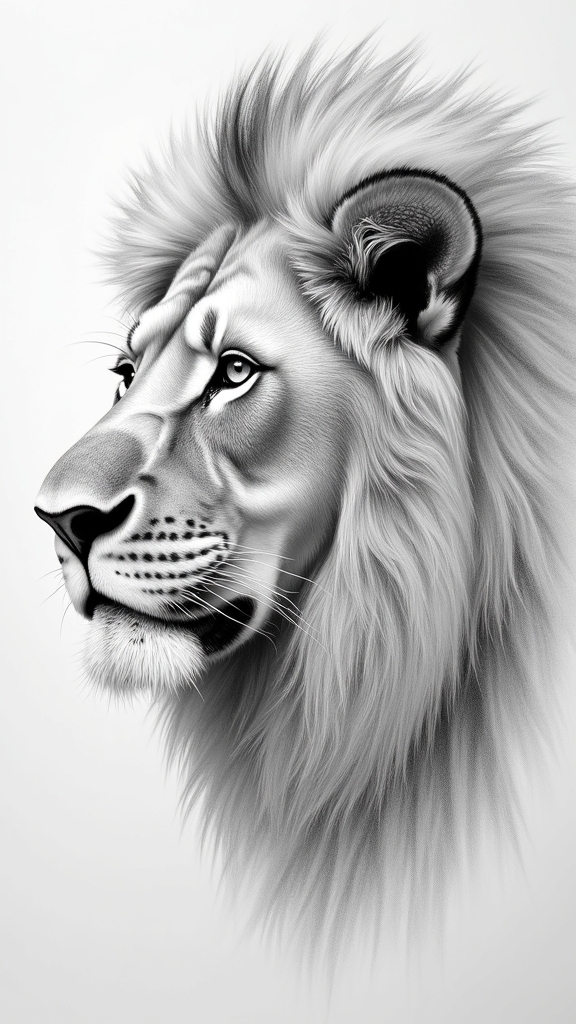
Even if someone’s never held a pencil in their life, seeing a realistic animal portrait can make them do a double-take.
Artists who specialize in realistic animal portraits know their secret: understanding anatomy is everything. Close observation of real animals—whether it’s a fluffy cat, a wise old owl, or a bouncy puppy—helps capture their unique fur, feathers, and those “aww”-inspiring eyes.
Mastering animal portraits starts with one key ingredient: careful anatomy study and close observation of each creature’s singular charm.
Using a mix of hard and soft pencils, they layer shades and textures using clever techniques like hatching and cross-hatching. The real magic happens when they reference high-quality photos or, if they’re brave, a wiggly pet—this helps nail those tricky poses.
Not to mention, learning from pros who’ve mastered realism adds extra “wow” to every drawing session.
Expressive Human Faces
When it comes to pencil portraits, nothing grabs attention quite like a face bursting with emotion—whether it’s a wild grin, a suspicious squint, or that classic “I’m not mad, just disappointed” mom look.
Getting expressions right means keeping an eye on proportions and the way each face shifts with every mood, which honestly can feel like solving a puzzle with a pencil.
Some artists go for jaw-dropping realism, while others twist things up with exaggerated, stylized features, and both styles can make your art shout instead of whisper.
Capturing Emotional Expressions
Take a close look at someone’s face—the tiny twitch of an eyebrow, the curve of a grin, or the wide-open eyes that scream surprise—and it’s like reading a story without any words.
Capturing emotional expressions in pencil art is all about sharp observation and using smart drawing techniques. Artists pay special attention to how eyebrows tilt or mouths shift, because these small moves completely change a character’s mood.
Shading tricks like cross-hatching and stippling help sculpt those feelings, making smiles gentle or frowns deep.
Want to get better? Try sketching faces showing happiness, anger, or even boredom—just for fun. Studying famous portraits can give plenty of tips, too.
Artists who practice different expressions gain the power to make their portraits truly speak.
Exploring Facial Proportions
Learning to show emotion on paper gets a lot easier once an artist understands the “blueprint” of a face. Think of facial proportions as a secret map: it’s not magic, but knowing where things go makes your drawing skills jump by leaps and bounds!
The average face divides into three equal parts—hairline to eyebrows, eyebrows to nose, and nose to chin—kind of like slicing a pizza nobody wants to share.
Eyes? They’re halfway down the head and about an eye-width apart. The mouth lines up with the centers of the eyes and sits about a third down from the nose to chin.
Noses curve and stick out in surprising ways, so studying their 3D shape matters. Practice from all angles—faces never sit still!
Stylized vs. Realistic Portraits
There’s a fascinating tug-of-war between stylized and realistic portraits, and artists have been picking sides—or mixing them up—for centuries.
Pencil drawings of human faces offer endless ways to explore this duel. Stylized portraits crank up the drama, with wild expressions or huge eyes, showing off a person’s personality more than their passport photo accuracy.
Realistic portraits, on the other hand, sweat the small stuff: detailed shading, exact proportions, and every subtle curve matters. Each approach needs a solid grip on facial anatomy, whether it’s for perfect features or those exaggerated cartoons. Mixed techniques? Always an option!
- Stylized pencil drawings exaggerate facial features for emotional impact.
- Realistic portraits demand patience, accuracy, and eagle-eyed observation.
- Graphite pencils work best for super fine details.
- Practicing both styles sparks creativity and personal flair.
Still Life With Everyday Objects
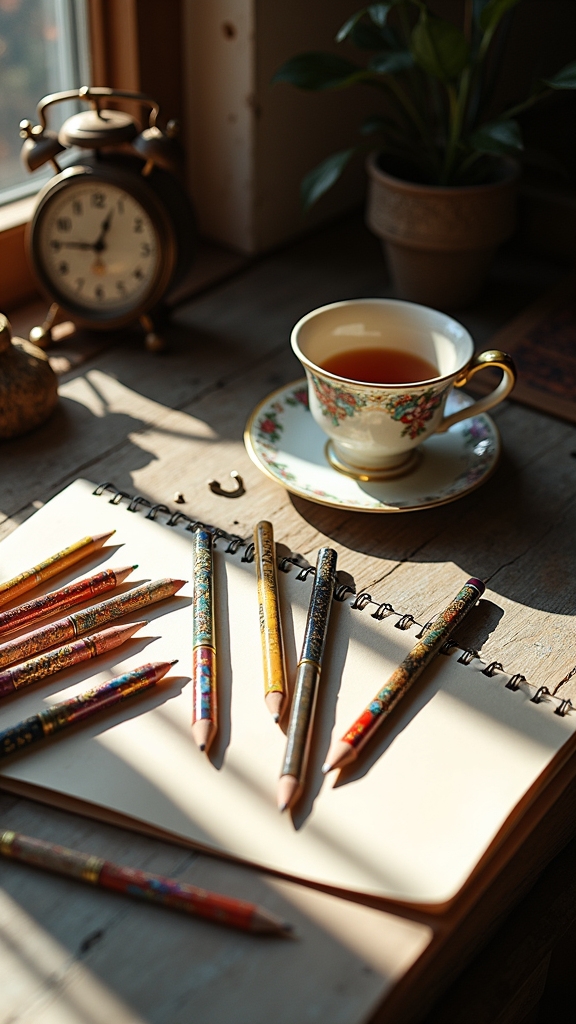
A bowl of apples, a crumpled paper bag, maybe even a favorite coffee mug—the best still life drawings often start with regular stuff found around the house.
With pencil sketching, artists have tons of fun exploring how these simple things can turn into seriously cool art! By arranging fruit, flowers, or other household objects, they get to mess around with composition, testing what looks best on the page.
Using pencils, artists practice shading to make apples shiny or bags wrinkly, trying hatching or stippling for interesting texture. Sometimes, even rearranging the objects—like stacking apples or turning the mug—changes the whole mood.
Natural light is a game-changer, throwing bold shadows and highlights everywhere. Plus, adding personal items makes the whole drawing feel meaningful and one-of-a-kind!
Whimsical Cartoon Characters
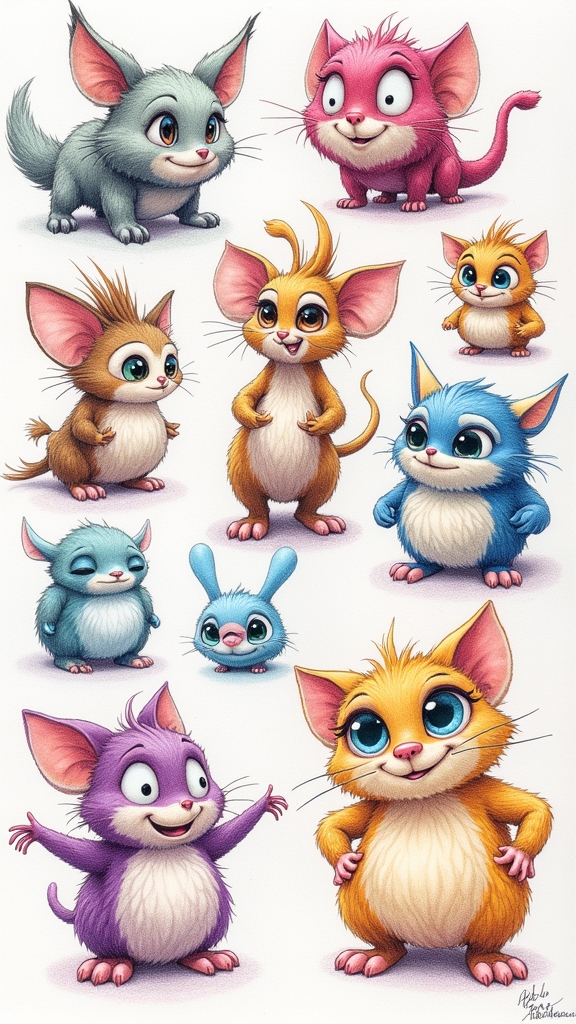
Ever wonder how artists dream up those wacky, wide-eyed cartoon characters that seem to pop right off the page? It all starts with bold pencil lines, letting the imagination run wild.
These whimsical cartoon characters rely on exaggerated proportions—think gigantic heads or tiny feet—and the silliest faces you can dream up. Every funky hairstyle, dynamic pose, or goofy grin is crafted to bring out the character’s unique personality.
Whimsical cartoon characters shine with giant heads, wild poses, and the silliest expressions you can imagine—each bursting with playful personality.
Instead of focusing on super-realistic details, artists experiment with simplified shapes and use vibrant pencil lines to make each figure eye-catching and fun.
- Play with oversized facial features and zany body shapes
- Give characters quirky outfits or accessories that hint at hobbies
- Use loose, energetic pencil lines to show movement or mood
- Mix classic cartoon styles with your own for fresh ideas
Surreal Landscapes
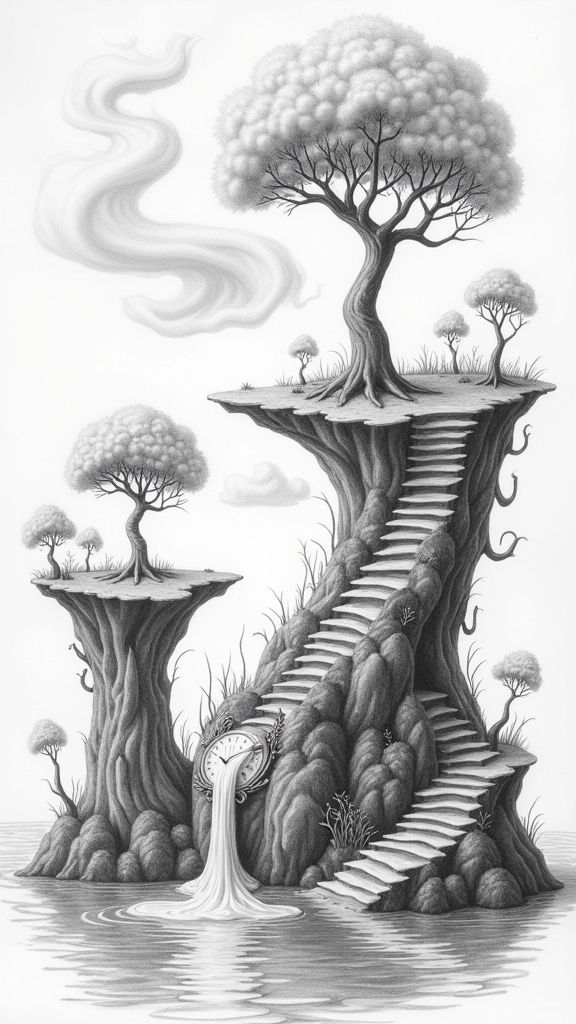
Surreal settings are where wild imagination takes over, mixing dreamlike natural vistas with weird twists that you’d never see outside of your own dreams.
Imagine a forest floating upside-down in space or a beach with clouds rolling in like waves—these kinds of unusual space elements and imaginative environmental details make every drawing feel like a new mystery to solve.
Artists get to bend the rules, mash up strange ideas, and maybe even confuse viewers in the best possible way.
Dreamlike Natural Vistas
Even when a scenery looks familiar, tossing in some wild, dreamlike twists can make it feel like you’ve landed in the middle of an enchanted storybook.
With Pencil Drawing, artists can take a normal mountain or forest and spin it into a place full of floating islands or rivers that zigzag up into the sky. Picture trees with branches like swirling ribbons, or rocks that float as if they’ve forgotten all about gravity.
To bring out that dreamlike feeling, try combining layers of shading and experimenting with odd textures. Let’s not forget, adding streaks of mist or mysterious lighting helps build that magical atmosphere.
Here are some ways to create dreamlike natural vistas:
- Mix realistic features with unexpected shapes
- Play with lighting to add mystery
- Experiment using layered Pencil Drawing
- Study surrealist artists for inspiration
Unusual Space Elements
While some terrains stay firmly stuck in the rules of nature, others seem to throw out the handbook entirely and let imagination take over. That’s where unusual space elements burst onto the scene!
In this drawing style, imagine floating islands drifting like clouds or skyscrapers twisting into impossible spirals. Maybe a moon hangs out way too close, or stars dot the skyline at noon—totally strange, but seriously eye-catching.
Artists love to play with blending and layering here, giving their drawings wild depth and textures. Sticking to a limited color palette or tossing in bold contrasts pushes these surreal touches even further.
Inspiration is everywhere: Salvador Dalí’s paintings, daydreams, or just a really weird idea that pops up during homework. The wilder, the better!
Imaginative Environmental Details
Dream logic rules in the world of imaginative environmental details, where the ordinary turns totally upside down. Surreal terrains might show rivers bending into the sky, cities swallowed by giant vines, or deserts flooded with glowing waterfalls.
With colored pencil, everyday places are flipped into wild, unexpected scenes—think lush forests full of massive mushrooms or floating islands drifting above a wavy ocean. Artists mix realistic touches with weird, fantastical twists, making viewers wonder what’s possible in their own dreams.
Blending vibrant colors makes the weirdness pop, adding mystery everywhere you look. For extra interest, try mixing nature and technology—a treehouse sprouting from a skyscraper, maybe?
- Giant objects in tiny environments
- Unexpected color schemes
- Blended elements for smooth shifts
- Nature overtaking man-made structures
Urban Architecture Studies
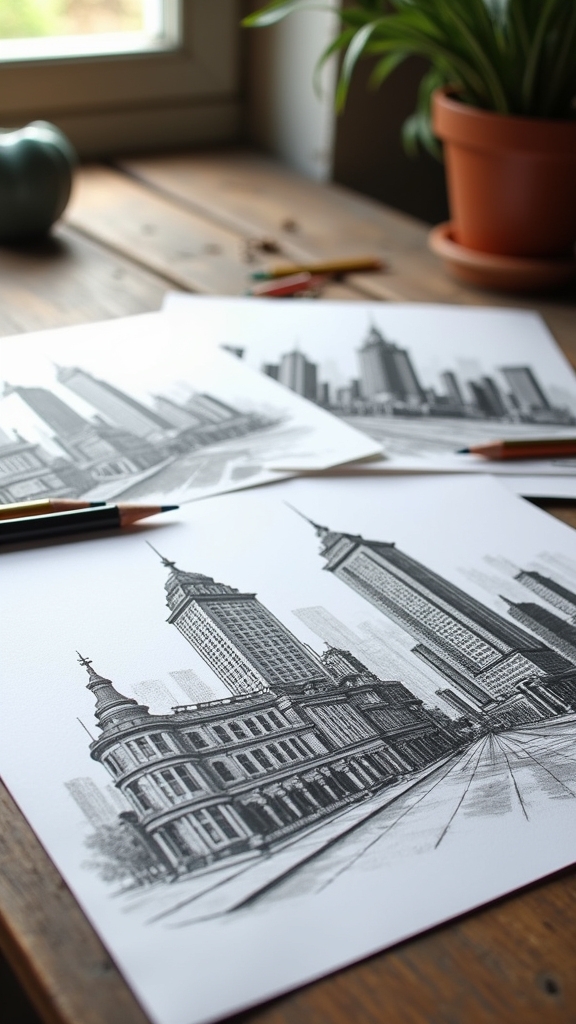
A city can feel like a giant labyrinth made of glass, steel, and stone, just waiting to be explored with a pencil. Urban architecture studies let artists capture the wild energy of buildings, streets, and twisting alleyways. It’s all about noticing those dramatic shadows, shiny windows, and the odd shapes that make up city skylines. With a pencil, artists play with perspective to make scenes pop out in 3D, using hatching to show crunchy brick walls or smooth concrete. Some go for super-realistic scenes, while others get a little wild, turning rooftops and fire escapes into cool geometric shapes. Observational studies in cities really help artists understand how big or small things should look, for drawings that make viewers stop and stare.
| Building Type | Pencil Technique | Fun Challenge |
|---|---|---|
| Skyscraper | Hatching | Drawing all windows |
| Old Factory | Cross-hatching | Capturing textures |
| Townhouse | Perspective lines | Getting proportions |
| Train Station | Blending shading | Showing movement |
Abstract Pattern Designs
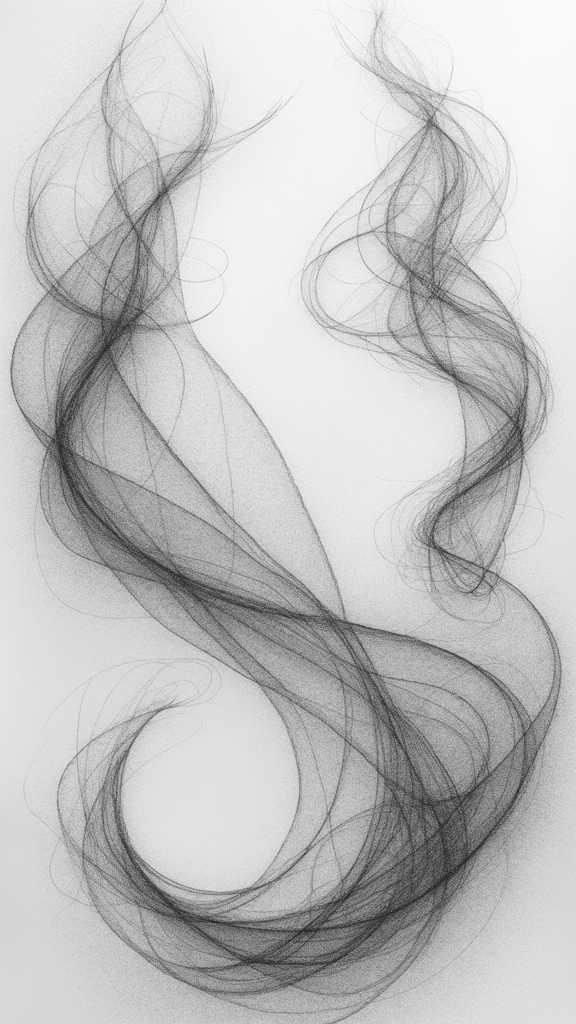
So many wild ideas can come to life with abstract pattern designs, where there’s no need to worry about drawing things the “right” way. Instead, these designs let artists play with shapes, lines, and maybe a little chaos—no rules, just imagination.
Geometric shapes are the real stars—think triangles stuffed in boxes, circles stacked like wobbly pancakes, or zigzags racing across the page. Want to crank up the drama? Mix in some thick and thin lines, uneven spacing, or even use colored pencils and ink for wild pops of color and texture.
Abstract patterns aren’t just cool-looking; they help artists get better at line work and shading, all while having fun with endless combinations.
- Draw geometric shapes inside outlined boxes
- Experiment with line thickness
- Use repeated patterns for visual rhythm
- Layer colored pencils or ink for texture
Chaotic Doodle Mash-ups
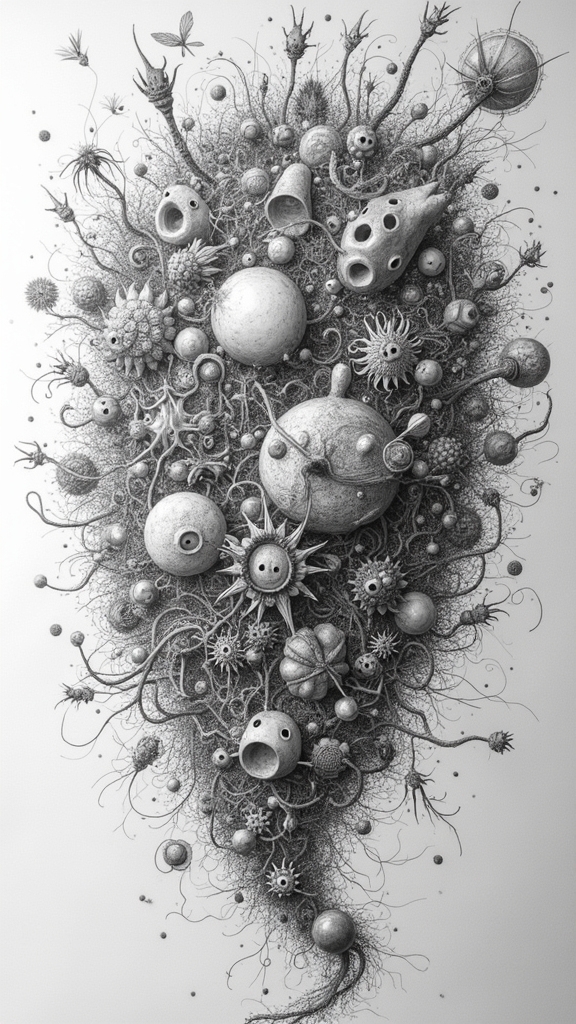
When it comes to chaotic doodle mash-ups, letting go of perfection and just scribbling what feels right is the real magic.
Wild patterns crash into odd shapes, and lines zigzag everywhere, making each sketch full of surprises and a little bit of organized chaos.
It’s all about seeing where expressive lines can take you—even if that means your page looks like a tornado of patterns decided to throw a party.
Embracing Imperfect Spontaneity
While some artists worry about every single line being perfect, chaotic doodle mash-ups flip that idea on its head and basically throw the rulebook right out the window.
Instead of following strict lines and careful shading, artists embrace wild strokes and unpredictable shapes, letting their pencils roam wherever their minds drift. Chaotic doodles are all about raw energy and capturing a sense of play.
Getting messy and layering lines can be weirdly freeing, especially if you’ve been away from art for a while and perfectionism is kicking your butt. The best part? The messier it gets, the cooler it looks.
- Mix lines in all directions for a dynamic effect
- Layer doodles on top of each other for depth
- Add unexpected elements for surprise
- Play with contour and parallel hatching for texture
Mixing Patterns and Forms
Sometimes, it seems like the wildest pencil drawings come from smashing together all sorts of patterns and forms, the way a DJ remixes songs. Mixing patterns and forms in chaotic doodle mash-ups is all about breaking the rules—with zig-zags, spirals, dots, blobs, and squiggles all dancing together on one page. Overlapping shapes, wonky lines, and surprise elements keep things unpredictable and fun. Artists love to experiment with shading tricks like stippling and cross-hatching, making the chaos pop with texture. It’s a cool way to loosen up and shake off art nerves, too. To keep it lively but not totally out of control, a hint of structure helps. Here’s a quick look at chaotic doodle mash-ups in action:
| Pattern | Form | Texture/Techniques |
|---|---|---|
| Spirals | Blobs | Cross-hatching |
| Checkerboard | Triangles | Stippling |
| Swirls | Stars | Scribbling |
| Dots | Abstract | Layered Shading |
| Zig-zags | Faces | Back-and-forth line |
Expressive Line Exploration
After splashing patterns and wild forms all over the page, things get even more electric with expressive line exploration—chaotic doodle mash-ups at their finest.
This isn’t about playing nice and neat; it’s about letting your pencil go a little bonkers, mixing lines and shapes however you want. Just grab your sketchbook, and dive right in! The more lines you layer and scramble, the more alive your artwork feels.
Embrace messiness, because imperfections actually make chaotic doodle mash-ups super interesting. Every line zigzags with energy and surprise, giving your drawing loads of personality.
Worried about making mistakes? Don’t be! The messier, the better.
- Try wild contour and parallel hatching.
- Use fast, looping strokes for energy.
- Stack and collide shapes randomly.
- Celebrate happy accidents—they’re gold!
Detailed Insect Illustrations
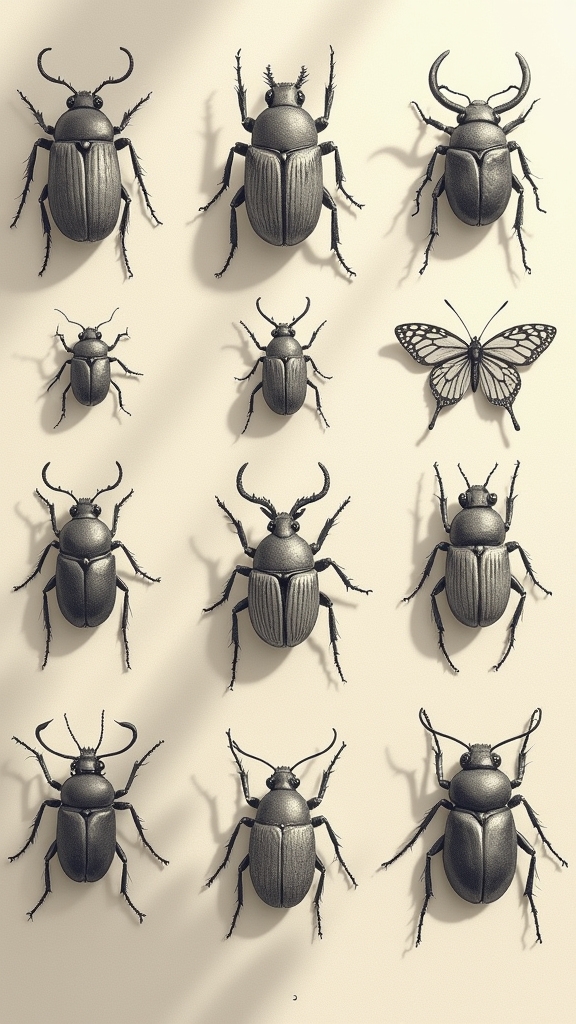
Detailed insect illustrations are where art and the wild world meet in a burst of tiny, jaw-dropping beauty. Think of all those cool patterns on butterfly wings or the shiny armor of a beetle—artists go wild bringing these out with graphite.
Using stippling (that’s just fancy dot-making) and cross-hatching, they make bug bodies look almost real enough to crawl off the paper. Sharp pencils highlight tiny veins; softer leads shade in shadows and make things pop.
To keep things accurate—and not accidentally give a dragonfly six toes—artists usually peek at photos or real bugs. Plants and flowers sometimes sneak into these drawings too, showing where these insects live and buzz around.
It’s all about celebrating nature’s awesome detail!
Fantasy Creature Concepts
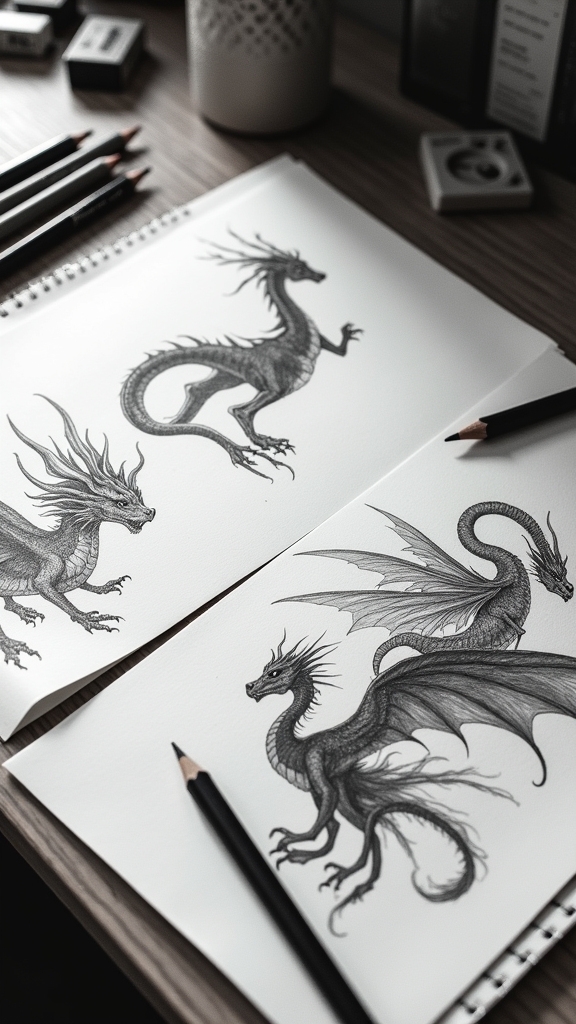
Monsters, dragons, and magical beasts—fantasy creature concepts invite artists to invent their own wild worlds, breaking every rule nature ever made.
Drawing fantasy creatures is like mixing up all your favorite animal parts and tossing in some weird, cool surprises. Maybe it’s a dragon with peacock feathers, or a cat with tree branches for a tail—there are absolutely no boring rules here!
Invent fantasy creatures by blending animal features and adding quirky surprises—no rules, just endless possibilities for your imagination!
Using bright colors can make those creatures pop right off the page, while dark shadows can give them a mysterious vibe. And hey, creating a wild backstory might just lead to a creature with extra horns or petals for fur.
Bring your pencil and let your imagination run wild!
- Combine animal features for original designs
- Use color theory for striking fantasy creatures
- Add nature elements for creative details
- Develop backstories to inspire new traits
Classical Figure Drawing
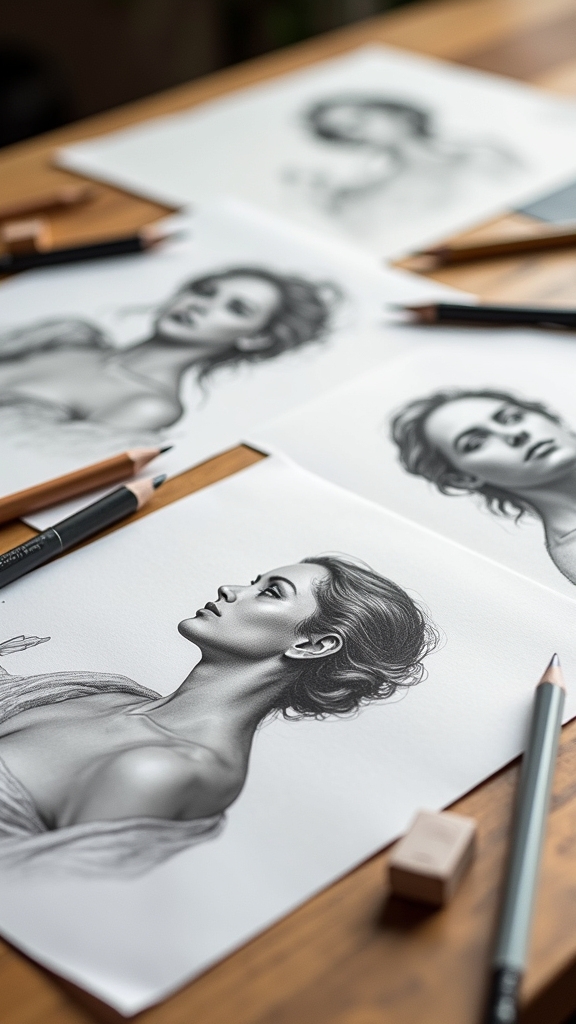
Classical figure drawing is like the Olympics of pencil art—artists challenge themselves to capture the human body just right, kind of like drawing superheroes, but with rules set by history’s greats.
For anyone hunting for solid Drawing Ideas, this style is all about nailing proportions, getting the twist of a pose, and understanding the flow of muscles. Think of it as studying from the masters—Renaissance legends obsessed over anatomy, and today’s artists often practice with Bargue Plates to sharpen their skills.
Pencil is the go-to tool for classic figure sketches, thanks to its ability to make subtle lines and smooth shading. It takes patience, careful observation, and lots of practice drawing from life—or statues—before you can catch that emotional spark in a realistic figure.
Dynamic Action Poses
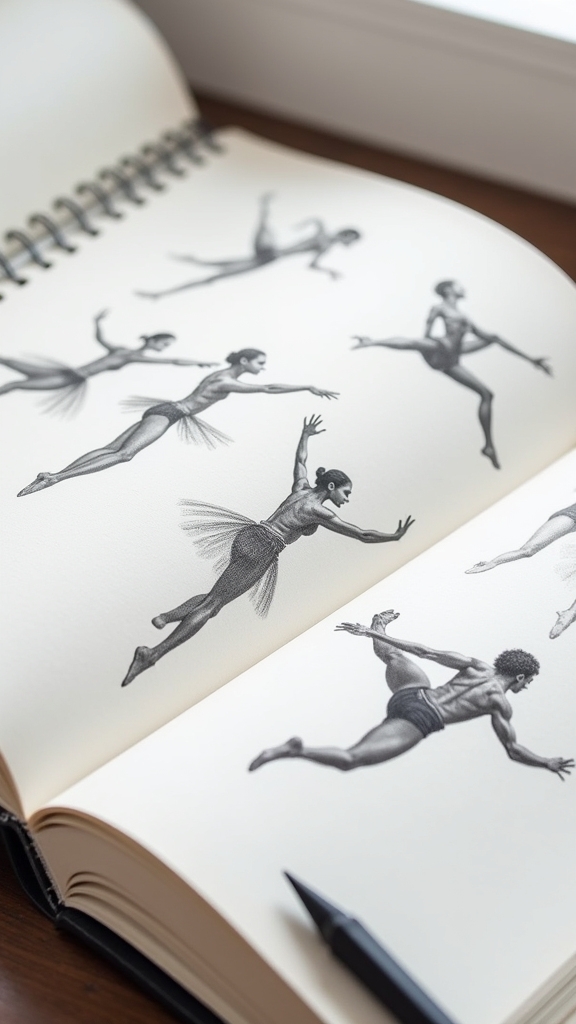
After getting the hang of classic figure drawing, some artists get an itch for more excitement—like, what if that statue suddenly jumped off its pedestal and sprinted across the room? That’s where dynamic action poses come in.
These sketches are all about energy and movement; they make your characters feel alive, whether they’re athletes tumbling through the air or superheroes leaping tall buildings. Instead of stiff, boring models, you focus on fast, flowing lines that show direction and speed.
Anatomy and proportion still matter, but now you add foreshortening tricks to make arms or legs seem closer or farther away. The key? Practice gesture drawing to catch movement quickly and keep things fresh.
- Study the line of motion before you start.
- Use rapid gesture sketches for warmups.
- Add foreshortening for dramatic depth.
- Focus on anatomy to keep poses realistic.
Food and Dessert Arrangements

Food and dessert arrangements are perfect subjects for pencil art, especially when drawing sweet treat still lifes or stacks of layered pastries that just make you hungry.
From the shiny skin of apples to the crumbly edges of cupcakes, artists can have a blast capturing vibrant fruit compositions loaded with color and texture—even if only in shades of gray.
Plus, who wouldn’t want to practice sketching a towering cake slice or a bowl of cherries and call it “art homework”?
Sweet Treat Still Lifes
Nothing makes a viewer’s mouth water quite like a drawing packed with delicious details—think cupcakes piled high with swirling frosting, glossy chocolate bars, or a stack of donuts begging to be picked off the page.
When artists create sweet treat still lifes, they get to explore not just their love for snacks, but also for texture and color—even in black and white. Carefully drawing the shine on caramel, the swirl in icing, or the crumbs on a pastry, they give each dessert its own personality.
It’s not just about making folks hungry; it’s about testing skill and style!
- Emphasize shiny highlights on chocolate or candy wrappers for realism
- Use hatching or stippling to create fluffy frosting or crumbly textures
- Play with light and shadow on glassy icing
- Arrange treats to practice composition and perspective
Layered Pastry Textures
Cupcakes and chocolates are just the beginning—layered pastries take things up a notch for any artist craving a real challenge.
Imagine sketching a croissant, each flaky piece stacked with intricate details, or a mille-feuille bursting with creamy layers. To pull this off, artists rely on clever shading tricks—hatching and cross-hatching build depth, while stippling adds crunchy texture to every crust.
Get bold with your pencils! Blending turns whipped cream and frosting into dreamy soft clouds, almost good enough to eat.
For an arrangement that dazzles rather than overwhelms, follow the 70/30 rule: pick one pastry to showcase your best stuff, letting other elements chill quietly in the background.
With practice, those crumbly, buttery layers practically leap off your page!
Vibrant Fruit Compositions
A splash of bright fruit can turn a plain pencil sketch into a total showstopper. When learning to draw vibrant fruit compositions, artists should focus on all those wild colors and juicy textures—think oranges, strawberries, and kiwis.
Want your drawings to practically pop off the page? Try shading with cross-hatching or stippling to really capture that mouthwatering shine. Arranging fruit slices in swirling circles or fun overlapping piles keeps your art from feeling stiff.
Don’t be shy about adding leaves or blooms for extra flair—after all, fruit rarely travels alone!
- Experiment with colored pencils or watercolors along with graphite for bold, lively hues.
- Play around with fruit placement to add excitement or movement.
- Use different shading techniques to create shiny, realistic surfaces.
- Add leaves or flowers to round out your fruity arrangement.
Mythical Storytelling Scenes
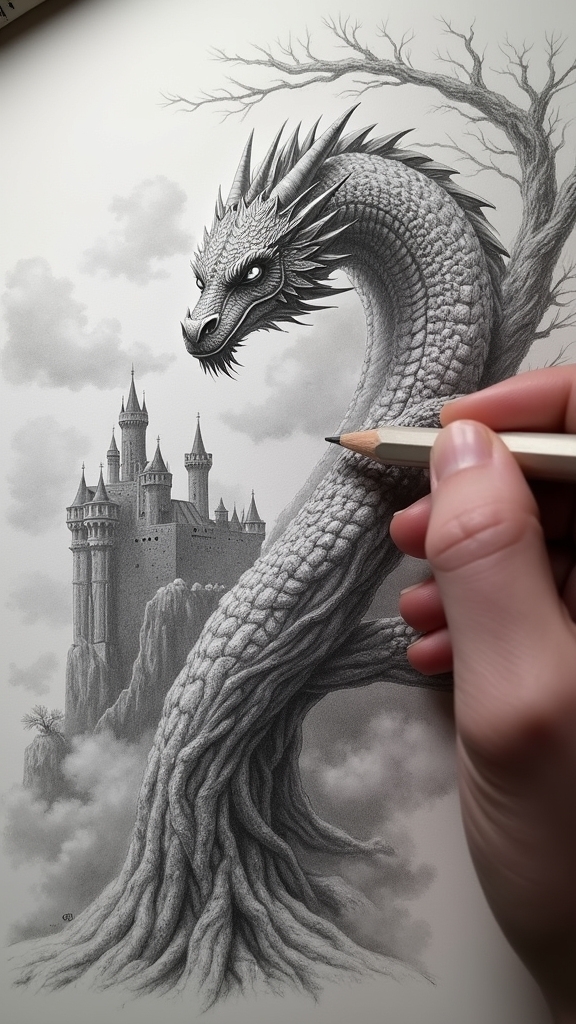
When it comes to pencil art, mythical storytelling scenes are where imagination really gets to show off. These types of drawings can be visually enchanting, because artists get to combine awesome characters—like gods, heroes, or even dragons—with wild, fantastical settings that seem to glow right off the page.
To make their stories even cooler, artists might toss in magical artifacts, mysterious symbols, or swirling clouds that look straight out of a dream. Want the scene to feel alive? Dynamic poses and dramatic expressions turn ordinary sketches into epic moments, whether it’s a hero defeating a monster or a wizard casting a spell.
Backgrounds like enchanted forests or sparkling night skies pull the viewer in, making the whole scene feel like a legend coming to life.
Textural Nature Studies
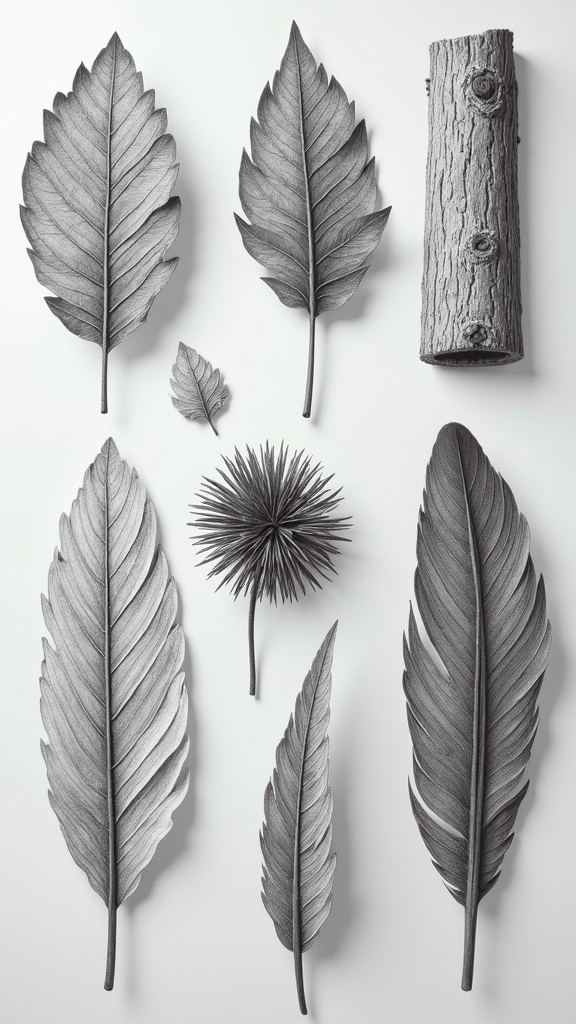
After drawing wild tales with wizards and dragons, it’s time to put down the magic wands and pick up a magnifying glass—because nature’s textures are ready for their close-up.
Textural nature studies focus on accurately depicting the tiny details found outside, like the wrinkles in tree bark or the maze of veins in a leaf. Artists use techniques like stippling, layering, or cross-hatching to bring leaves, rocks, or blades of grass to life.
Textural nature studies capture the smallest outdoor details—using stippling, layering, and cross-hatching to bring every leaf and blade of grass alive.
Switching between soft and hard pencils makes shading pop, creating depth and drama—like nature itself just jumped off the page! Observing real plants and sceneries keeps everything honest, and sometimes, a single blade of grass deserves its own portrait.
- Stippling for bumpy textures
- Cross-hatching for shadows
- Layering strokes for realism
- Observational sketching for accuracy
Geometric Shape Explorations

Triangles, circles, and squares—oh my! When diving into geometric shape explorations, it can feel like you’ve stumbled into a world of endless building blocks.
Artists break things down into simple geometric shapes, like cubes, spheres, and cylinders, to strengthen their drawing skills and supercharge their sense of space. It’s not just about drawing perfect shapes; it’s about training your hand to lay down clean, confident lines and nailing those tricky angles.
Imagine overlapping gigantic circles, tiny triangles, and wild-sized squares to invent mind-bending patterns—sounds fun, right?
Geometric shapes are the secret sauce for creating artworks bursting with rhythm and balance. Suddenly, flat drawings look 3D, popping with depth. It’s like art class, but with a dash of secret geometry wizardry.
Sketchy Fashion Illustrations
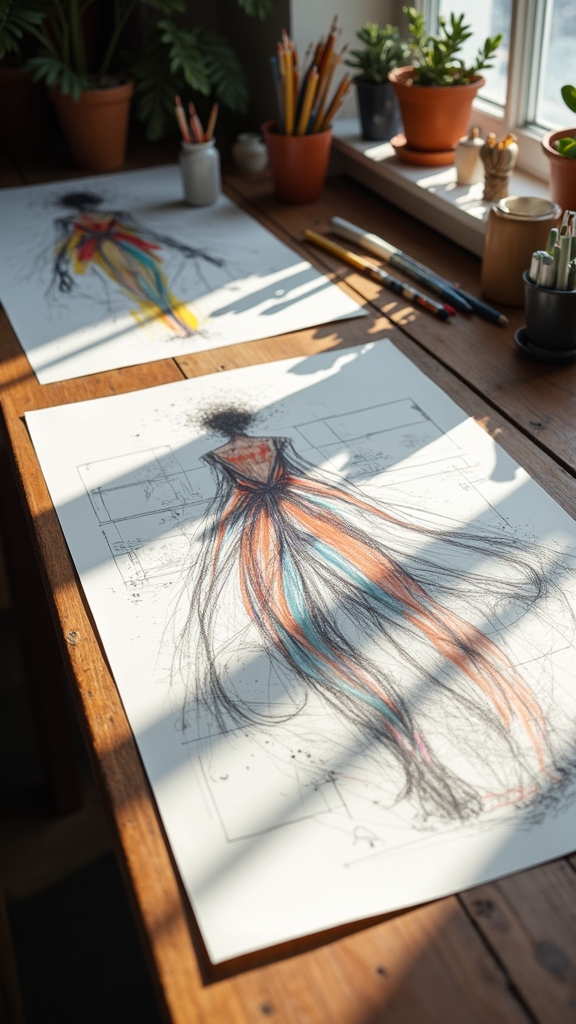
Swapping ruler-straight shapes for fast, swoopy lines, artists who tackle sketchy fashion illustrations get to release a totally different set of skills.
These drawings burst with energy, showing the movement of fabric and a bit of attitude, too. Forget about stiff, static poses; sketchy fashion drawing is all about loose lines that dance across the paper, hinting at everything from fluttering skirts to bold jackets.
Loose lines pulse with energy, capturing flowing fabrics and attitude—every swoop hints at movement, never stiffness, in sketchy fashion illustrations.
The focus is on capturing the big picture—the look, the mood—not every tiny detail. Stylizing things by exaggerating limbs or adding dramatic curves makes these illustrations pop.
- Experiment with line weights, like thick swooshes or delicate hatching, to create depth.
- Use a limited color palette to spotlight clothing shapes.
- Play with proportions and wild poses.
- Try fast, energetic sketches for quick concept drawing.
Atmospheric Environment Renderings
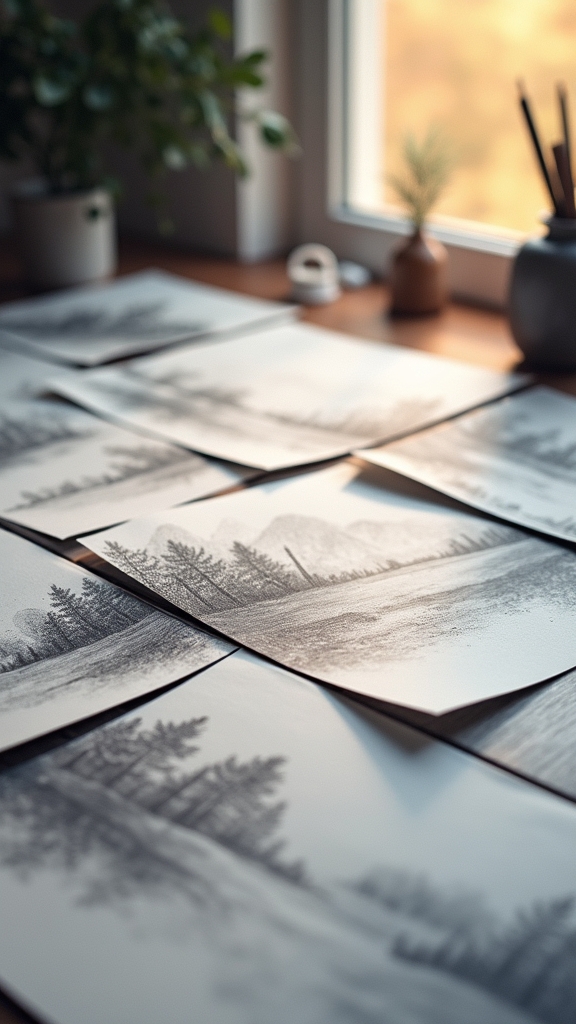
Every scenery tells a story, but atmospheric environment renderings crank up the drama with light, shadow, and a bit of magic. It’s more than just drawing a tree or a mountain—it’s about capturing how the morning fog hugs the ground, or how a sunset makes everything glow. Artists reach for shading techniques like hatching or cross-hatching to turn pencils into mood machines. Want to make a cliffside look extra lonely or a forest feel enchanted? Play with pencil grades and watch the scene come alive! And remember the 70/30 rule: focus most details where you want eyes to wander, then let some sections breathe. Check out this vibe table:
| Feeling | Technique Used |
|---|---|
| Mysterious Mist | Soft Shading, Blending |
| Intense Dawn | Bold Lines, Highlights |
| Calm Waters | Gentle Hatches, Layers |
Symbolic and Conceptual Artworks
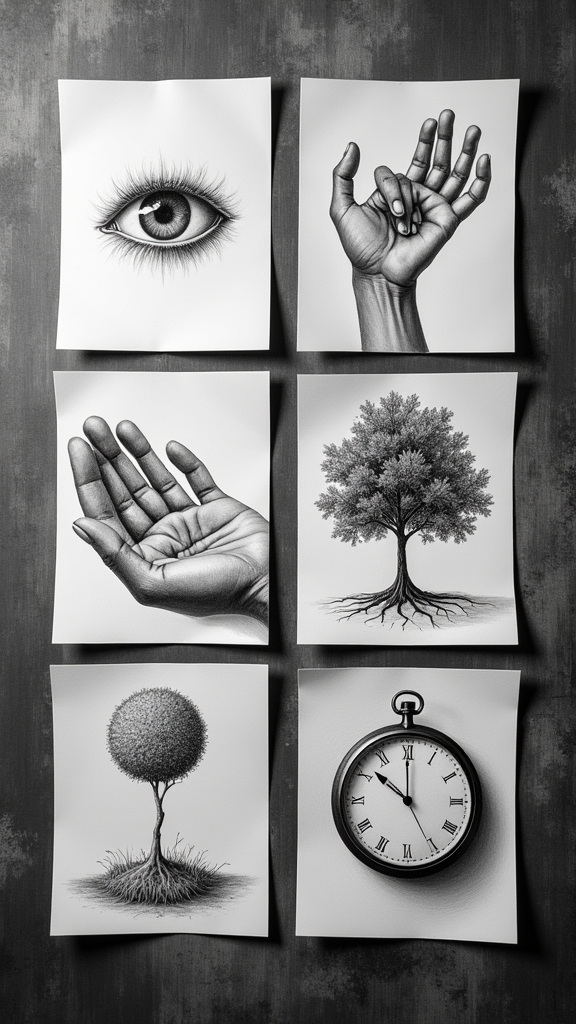
While mood and lighting can shape a scene, things get even deeper when artists play with symbols and big ideas. Symbolic and conceptual artworks are not just about what you see—they’re about what you feel and think, too!
Instead of only drawing something that looks real, artists immerse themselves in the world of metaphors and abstract images. Sometimes, a single bird or clock can represent huge things, like freedom or the passing of time. Want to look twice and think twice? That’s what these artworks are here for!
- Artists use common objects, like keys or masks, to symbolize deeper ideas and emotions.
- Juxtaposing unrelated things can spark questions or make you reconsider what you believe.
- Symbolic and conceptual artworks often tell stories that go way beyond the surface.
- The story behind the drawing can become even more important than the drawing itself!
Frequently Asked Questions
What Can an 11 Year Old Draw?
An 11-year-old seeking creative inspiration can draw animals, plants, and simple cartoon characters, practice beginner portraits, or illustrate scenic environments. These subjects foster creativity, support foundational skills, and encourage imaginative exploration through varied pencil art techniques and themes.
What to Draw 100 Ideas With a Pencil?
When seeking Creative Inspiration, one might consider compiling a list of 100 pencil drawing ideas. These could span themes like nature, portraits, animals, food, fantasy worlds, cityscapes, everyday objects, and imaginative scenes to encourage artistic exploration.
What Are the 10 Types of Drawing?
The current question explores ten types of drawing, highlighting various drawing techniques such as line drawing, shading, stippling, contour drawing, gesture drawing, hatching, blending, comic art, cartooning, and illustration, each offering unique expressive possibilities and approaches.
Is a 0.5 or 0.7 Pencil Better for Drawing?
When considering pencil thickness, neither 0.5 mm nor 0.7 mm is definitively better for drawing; selection depends on personal preference, desired detail, and technique. Artists often use both sizes, switching based on specific project requirements.
Conclusion
Pencil art isn’t just about drawing lines—it’s about creating magic on paper, and honestly, anyone can do it with a little practice. Whether you like doodling goofy cartoons, trying realistic animals, or sketching wild shapes, there’s a style that fits. Erasers are your best friends, and mistakes? Totally part of the process! So grab a pencil, pick an idea, and go for it. Who knows? Your next sketch could be your favorite masterpiece yet.

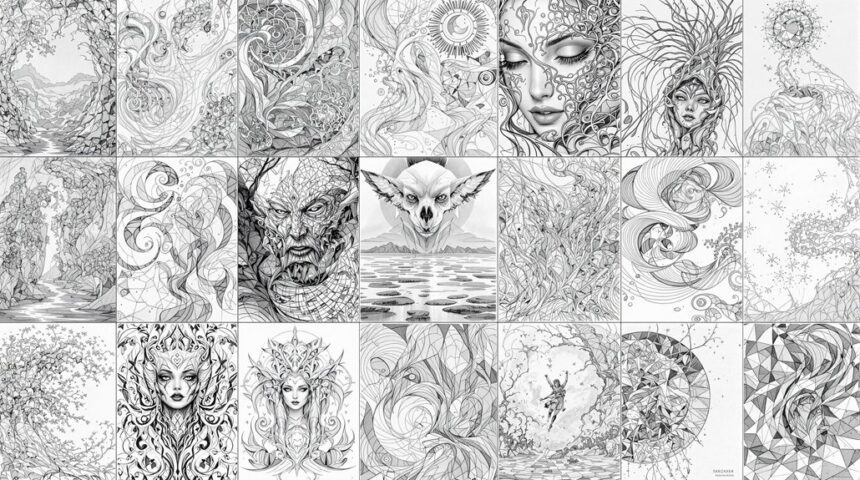
Leave a Reply